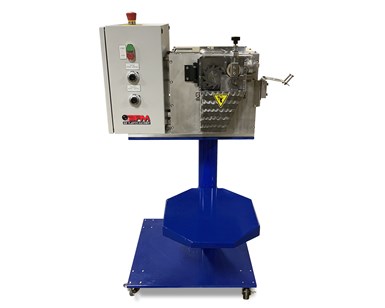Next-Generation Pelletizers
Bay Plastics Machinery Inc. (BPM) will be unveiling what it calls the next generation of pelletizing technology at K 2022 in Düsseldorf, Germany.
Bay Plastics Machinery Inc. (BPM) will be unveiling what it calls the next generation of pelletizing technology at K 2022 in Düsseldorf, Germany. Two new products will be on display.
First is BPM’s new AXP (HD) system, designed for heavy-duty pelletizing applications.
Offered in 12-in. and 16-in. cutting widths, the HD series features:
- Larger motors to provide more robust cutting for today’s engineered resins, including heavy glass-filled materials.
- The push-pull bed knife holder enables users to easily adjust the bed knife gap so that the cutter is consistent from end to end.
- The AXP (HD) features larger diameter rolls and bearings to reduce deflection across the cutting width.
- An optional gearbox lets HD series users engage both upper and lower feed rolls.

Photos: Bay Plastics Machinery
- Feed roll air cylinders are larger than the standard design so users can apply more clamping force as needed.
- The AXP (HD) pelletizer also offers an optional rotor coupling drive so that the rotor can remain free of belt load with higher horsepower options.
BPM will also debut the BT25X bench-top pelletizer for lab applications. The BT25X now uses industry standard AC motors and drives — the same as BPM’s full production models. In addition, new drives come in a wide range of voltages, making the BT25X accessible to companies across the globe.
Other benefits include:
- The BT25X’s safety circuit features a streamlined version of the Safe Torque Off (STO) function found in full production models, so it is even safer to operate.
- A wider speed range enables slower or faster production than previously available, plus the BT25X now offers the option of running in both batch or continuous modes.

- The addition of a control cabinet to house the drives means BPM’s BT25X has an increased environmental rating from its predecessor. A lockable rotary disconnect has also been added as a safeguard when performing maintenance procedures.
Related Content
-
Safety, Recycling, and Compounding Trends Bring New Opportunity to 70-Year-Old Company
NPE2024: Vac-U-Max presents pneumatic conveying solutions for powdered materials.
-
More Than a Compounder: They Have the Science to Create New Custom Materials
Insight Polymers & Compounders leverages its expertise in polymer chemistry to develop next-generation materials.
-
Engineering Resins Compounder Expands to Take on More Scrap
Polymer Resources responds to sustainability push by upgrading plant with grinding and shredding equipment to take on both postindustrial and postconsumer reclaim.








